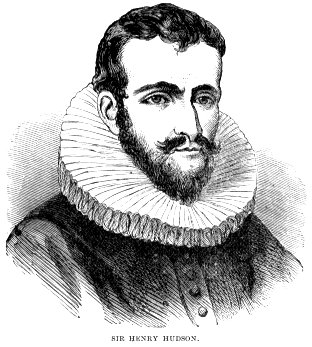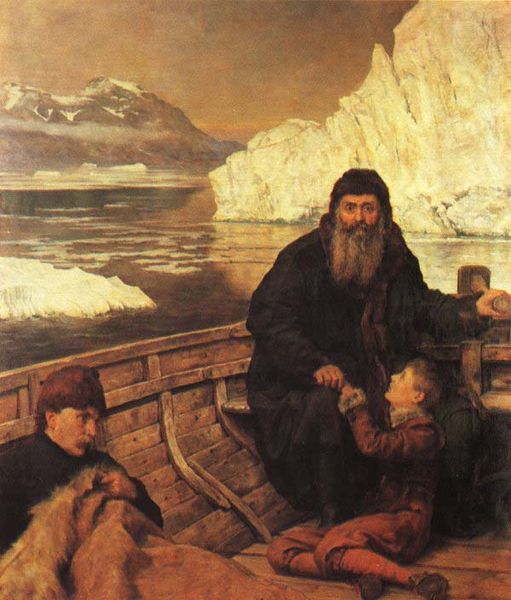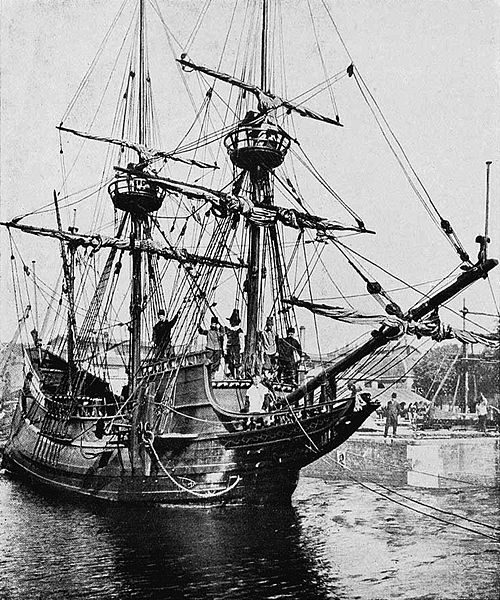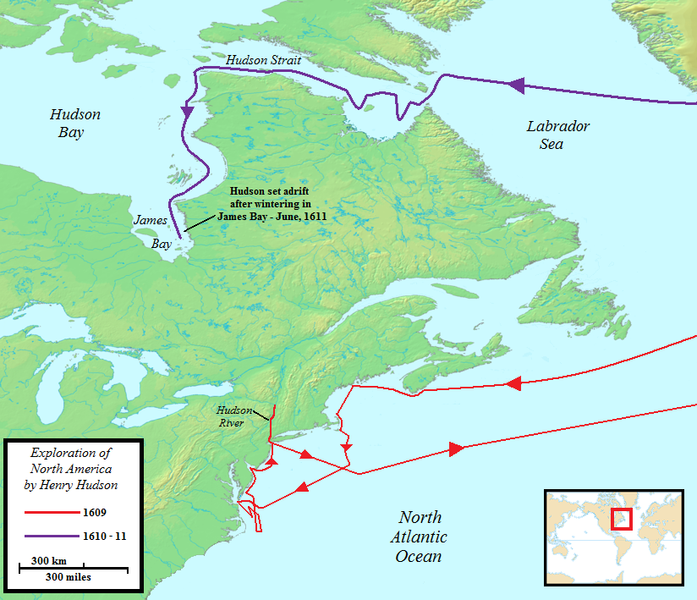<Back to Index>
- Explorer Henry Hudson, 1560/70s
- Painter Anselm Feuerbach, 1829
- King of France Francis I, 1494
PAGE SPONSOR


Henry Hudson (c. 1560/70s – 1611?) was an English sea explorer and navigator in the early 17th century. After several voyages on behalf of English merchants to explore a prospective Northeast Passage to India, Hudson explored the region around modern New York City while looking for a western route to Asia under the auspices of the Dutch East India Company. He explored the river which eventually was named for him, and laid thereby the foundation for Dutch colonization of the region.
Hudson discovered a strait and immense bay on his final expedition while searching for the Northwest Passage. In 1611, after wintering on the shore of James Bay, Hudson wanted to press on to the west, but most of his crew mutinied. The mutineers cast Hudson, his son and others adrift, and no one saw him or his companions again.
Details of Hudson’s birth and early life are mostly unknown. Some sources have identified Hudson as having been born circa 1565, while others place it around 1570. Other historians assert even less certainty. Hudson is thought to have spent many years at sea, beginning as a cabin boy and gradually working his way up to ship's captain. In 1607, the Muscovy Company of the Kingdom of England hired Hudson to find a northerly route to the Pacific coast of Asia.
The English were battling the Dutch for Northeast Passage routes. It
was thought at the time that, because the sun shone for three months in
the northern latitudes in the summer, the ice would melt and a ship
could make it across the top of the world to the McKenzie Islands.
Hudson sailed on the 1st of May with a crew of ten men and a boy on the
80-ton Hopewell. They reached the east coast of Greenland on
June 13, coasting it until the 22nd. Here they named a headland
"Young's Cape", a "very high mount, like a round castle" near it "Mount
of God's Mercy" and land at 73° N "Hold-with-Hope". On the 27th
they sighted "Newland" (i.e Spitsbergen), near the mouth of the great bay Hudson later simply named the "Great Indraught" (Isfjorden). On July 13 Hudson and his crew thought they had sailed as far north as 80° 23' N, but more likely only reached 79° 23' N. The following day they entered what Hudson later in the voyage named "Whales Bay" (Krossfjorden and Kongsfjorden), naming its northwestern point "Collins Cape" (Kapp Mitra) after his boatswain, William Collins. They sailed north the following two days. On the 16th they reached as far north as Hakluyt's Headland (which Thomas Edge claims Hudson named on this voyage) at 79° 49' N, thinking they saw the land continue to 82° N (Svalbard's
northernmost point is 80° 49' N) when really it trended to the
east. Ice being packed along the north coast, they were forced to turn
back south. Hudson wanted to make his return "by the north of Greenland
to Davis his Streights (Davis Strait), and so for Kingdom of England," but ice conditions would have made this impossible. The expedition returned to Tilberry Hope on the Thames on September 15. Many authors have
wrongly stated that it was the discovery of large numbers of whales in
Spitsbergen waters by Hudson during this voyage that led to several
nations sending whaling expeditions to the islands. While he did indeed
report seeing many whales, it was not his reports that led to the
trade, but that by Jonas Poole in 1610 which led to the establishment
of English whaling and the voyages of Nicholas Woodcock and Willem Cornelisz. van Muyden in 1612 that led to the establishment of Dutch, French and Spanish whaling. In 1608, merchants of the Muscovy Company again sent Hudson in the Hopewell on
another attempt at a passage to the Indies, this time to the east
around northern Russia. Leaving London in April, the ship made it to Novaya Zemlya in July, but the ice was impenetrable and they turned back, reaching England in late August.
According to Thomas Edge, "William [sic] Hudson" in 1608 discovered an island at 71° N and named it "Hudson's Tutches" (Touches). However, he only could have come across it in 1607 (if he had made an illogical
detour) and made no mention of it in his journal. There is also no cartographical proof of this supposed discovery. Jonas Poole in 1611 and Robert Fotherby in
1615 both had possession of Hudson's journal while searching for his
elusive Hold-with-Hope (on the east coast of Greenland), but neither
had any knowledge of his (later) alleged discovery of Jan Mayen. The latter actually found Jan Mayen, thinking it a new discovery and naming it "Sir Thomas Smith's Island". In 1609, Hudson was chosen by the Dutch East India Company to find an easterly passage to Asia. He was told to sail through the Arctic Ocean north of Russia, into the Pacific and so to the Far East. Hudson departed Amsterdam on April 4 in command of the Dutch ship Halve Maen. He
could not complete the specified route because ice blocked the passage,
as with all previous such voyages, and he turned the ship around in
mid-May while somewhere east of Norway's North Cape.
At that point, acting entirely outside his instructions, Hudson pointed
the ship west to try to find a passage in that direction. Having heard rumors of a passage to the Pacific, by way of John Smith of Jamestown and Samuel de Champlain, Hudson and his crew decided to try to seek a westerly passage through North America. The Native Americans who gave the information to Smith and Champlain were likely referring to what are known today as the Great Lakes (and which could not be reached via any navigable waterways). They reached the Grand Banks, south of Newfoundland, on July 2, and in mid-July made landfall near what is now LaHave, Nova Scotia. Here they encountered Native Americans who were accustomed to trading with
the French; they were willing to trade beaver pelts, but apparently no
trades occurred. The
ship stayed in the area about ten days, the crew replacing a broken
mast and fishing for food. On the 25th a dozen men from the Halve Maen,
using muskets and small cannon, went ashore and assaulted the village
near their anchorage. They drove the people from the settlement and
took their boat and other property (probably pelts and trade goods). On August 4 the ship was at Cape Cod, from which Hudson sailed south to the entrance of the Chesapeake Bay. Rather than entering the Chesapeake he explored the coast to the north, finding Delaware Bay but continuing on north. On September 3 he reached the estuary of
the river that initially was called the "North River" or "Mauritius"
and now carries his name. He was not the first to discover the estuary,
though, as it had been known since the voyage of Giovanni da Verrazzano in 1524. On September 6, 1609 John Colman of his crew was killed by Indians with an arrow to his neck. Hudson sailed into the upper bay on September 11, and the following day began a journey up what is now known as the Hudson River. Over the next ten days his ship ascended the river, reaching a point about where the present-day capital of Albany is located. On September 23, Hudson decided to return to Europe. He put in at Dartmouth on
November 7, and was detained by authorities who wanted access to his
log. He managed to pass the log to the Dutch ambassador to England, who
sent it, along with his report, to Amsterdam. While
exploring the river, Hudson had traded with several native groups,
mainly obtaining furs. His voyage was used to establish Dutch claims to
the region and to the fur trade that prospered there when a trading post was established at Albany in 1614. New Amsterdam on Manhattan Island became the capital of New Netherland in 1625.
In 1610, Hudson managed to get backing for yet another voyage, this time under the English flag. The funding came from the Virginia Company and the British East India Company. At the helm of his new ship, the Discovery, he stayed to the north (some claim he deliberately stayed too far south on his Dutch-funded voyage), reaching Iceland on May 11, the south of Greenland on June 4, and then rounding the southern tip of Greenland. Excitement was very high due to the expectation that the ship had finally found the Northwest Passage through the continent. On June 25, the explorers reached what is now the Hudson Strait at the northern tip of Labrador. Following the southern coast of the strait on August 2, the ship entered Hudson Bay.
Hudson spent the following months mapping and exploring its eastern
shores, but he and his crew did not find a passage to Asia. In
November, however, the ship became trapped in the ice in the James Bay, and the crew moved ashore for the winter. When
the ice cleared in the spring of 1611, Hudson planned to continue
exploring but his crew wanted to return home. Matters came to a head and the crew mutinied in June. The people in charge of the mutiny were Hudson's close friends, Robert Juet and Henry Greene (according to Abacuk Pricket's
journal). According to the mutineers, they set Hudson, his teenage son
John and six crewmen — either sick and infirm or loyal to Hudson — adrift
in a small open boat, effectively marooning them. According to
Pricket's journal, the castaways were provided with powder and shot,
some pikes, an iron pot, some meal, and other miscellaneous items, as
well as clothing. However, Pricket knew he and the other mutineers
would be tried in England. The small boat kept pace with the Discovery for some time as the abandoned men rowed towards her, but eventually the Discovery's
sails were let loose. Hudson was never seen again, and his fate is not
known. However, it has been speculated that Hudson was killed by his
crew. Only
8 of the 13 mutinous crewmen survived to return to Europe but, although
arrested, none were ever punished for the mutiny. One theory holds that
they were considered valuable as sources of information, having
traveled to the New World. Perhaps
for this reason, they were charged with murder — of which they were
acquitted — rather than mutiny, of which they most certainly would have
been convicted and executed. The gulf or bay discovered by Hudson is twice the size of the Baltic Sea, and its many large estuaries afford access to otherwise landlocked parts of Western Canada and the Arctic. This allowed the Hudson's Bay Company to
exploit a lucrative fur trade along its shores for more than two
centuries, growing powerful enough to influence the history and present international boundaries of Western North America. Hudson Strait became the entrance to the Arctic for all ships engaged in the search for the Northwest Passage from the Atlantic side. The Hudson River in New York and New Jersey, explored earlier by Hudson, is named after him, as are Hudson County, New Jersey, and the town of Hudson, New York. He also appears as a mythic character in the famous story of Rip Van Winkle by Washington Irving.

